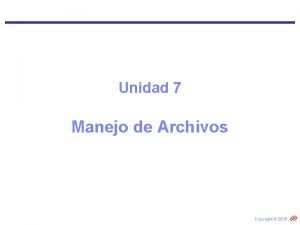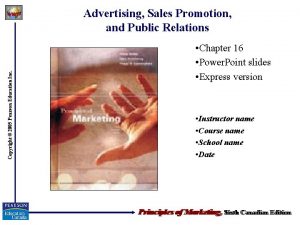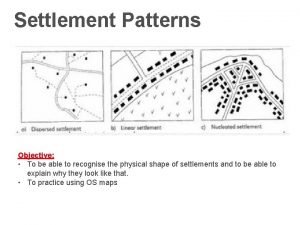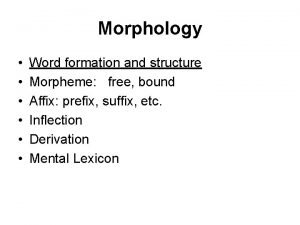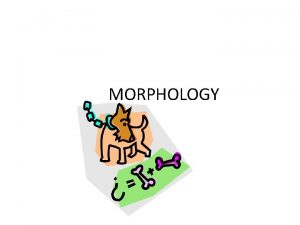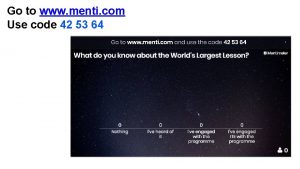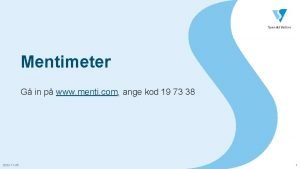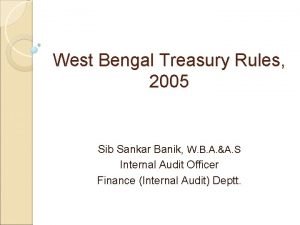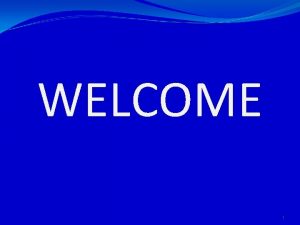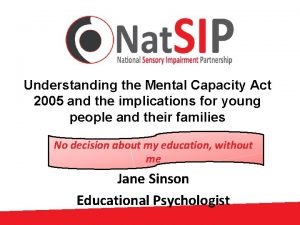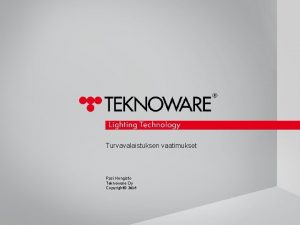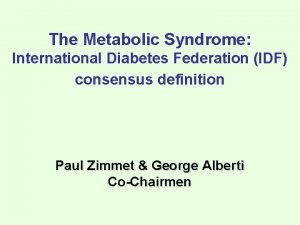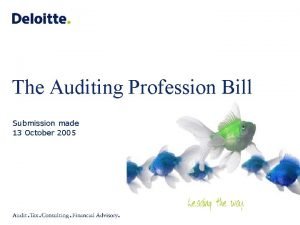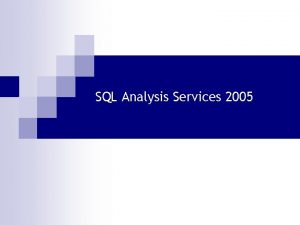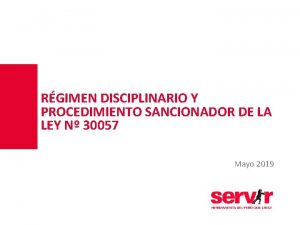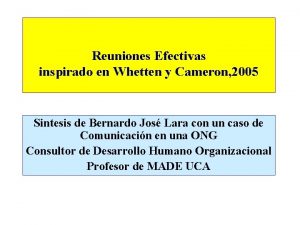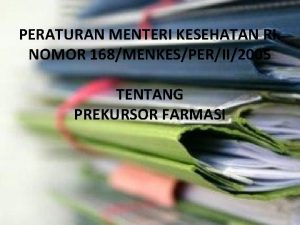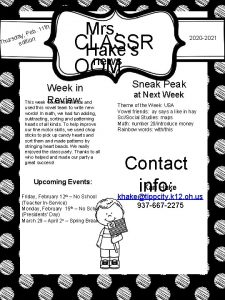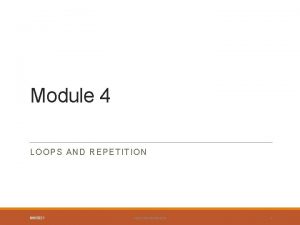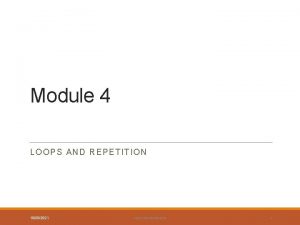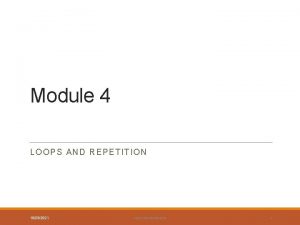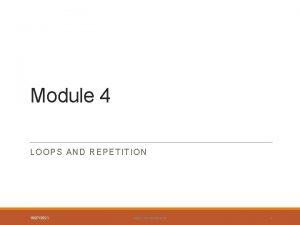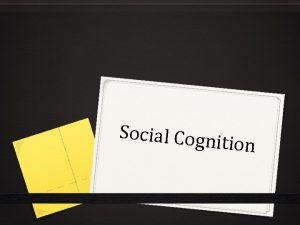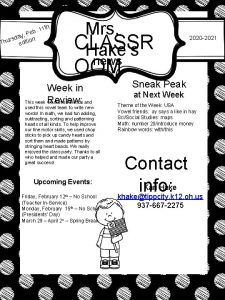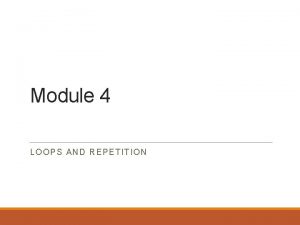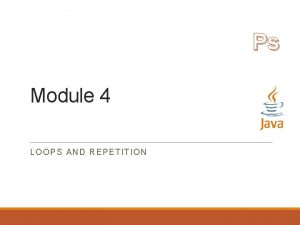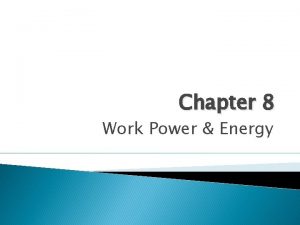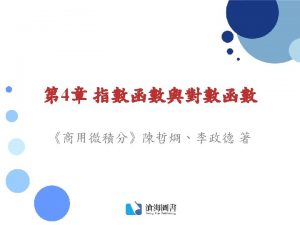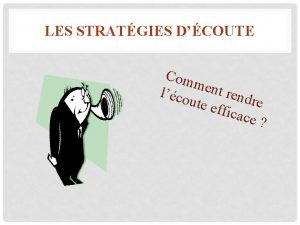CHAPTER 12 ment ition illiams 1 Copyright 2005






































- Slides: 38

CHAPTER 12 ment ition illiams 1 Copyright © 2005 by South-Western, a division of Thomson Learning. All rights reserved

What Would You Do? You are the new CEO of Advantica… . Denny’s has paid $54 million in damages due to customer discrimination. Advantica, which now owns Denny’s, wants to change the culture How do you create a diversity plan and make changes throughout the company? What steps could you take to communicate to customers that Denny’s will change? 2 Copyright © 2005 by South-Western, a division of Thomson Learning. All rights reserved

Predicted U. S. Population, by Race, 2005 -2070 3 Copyright © 2005 by South-Western, a division of Thomson Learning. All rights reserved

Diversity and Why It Matters After reading the next section, you should be able to: 1. describe diversity and why it matters. 4 Copyright © 2005 by South-Western, a division of Thomson Learning. All rights reserved

Diversity: Differences That Matter Diversity Is Not Affirmative Action How to Build a Business Case For Diversity 1 5 Copyright © 2005 by South-Western, a division of Thomson Learning. All rights reserved

Diversity Is Not Affirmative Action Diversity Affirmative Action . May exist without a program . A purposeful, established program . Broad focus . Narrow focus . Not legally based . Legal requirement . Create a positive work environment . Compensate for past discrimination . Generally accepted . Controversial 1. 1 Copyright © 2005 by South-Western, a division of Thomson Learning. All rights reserved 6

General Purpose of Diversity Programs To create a positive work environment where § no one is advantaged or disadvantaged § “we” is everyone. § everyone can do his or her best work. § differences are respected and not ignored. § everyone feels comfortable. 1. 1 Copyright © 2005 by South-Western, a division of Thomson Learning. All rights reserved Adapted from Exhibit 12. 2 7

Diversity Makes Good Business Sense Cost Savings Attracting and Retaining Talent Driving Business Growth 1. 2 Copyright © 2005 by South-Western, a division of Thomson Learning. All rights reserved 8

Diversity Makes Good Business Sense Cost Savings. Reduces turnover. Decreases absenteeism. Avoids expensive lawsuits 1. 2 Copyright © 2005 by South-Western, a division of Thomson Learning. All rights reserved 9

Diversity Makes Good Business Sense Attracting and Retaining Talent. Attracts better and more diverse job applicants. Have higher stock market performance. Encourages workers to stay 1. 2 Copyright © 2005 by South-Western, a division of Thomson Learning. All rights reserved 10

Diversity Makes Good Business Sense Driving Business Growth. Improves understanding of the marketplace. Improves quality of problem solving 1. 2 Copyright © 2005 by South-Western, a division of Thomson Learning. All rights reserved 11

Been There Done That Diversity at Longo Toyota Ken Rankin, HR manager at Longo Toyota retains 90 percent of its diverse staff. Diversity would not happen if the job fell solely to HR. HR hires the most qualified for the position. Diversity adds talent and is a strength 12 Copyright © 2005 by South-Western, a division of Thomson Learning. All rights reserved

Diversity and Individual Differences After reading the next two sections, you should be able to: 2. understand the special challenges that the dimensions of surface-level diversity poses for managers. 3. explain how the dimensions of deep-level diversity affect individual behavior and interactions in the workplace. 13 Copyright © 2005 by South-Western, a division of Thomson Learning. All rights reserved

Surface and Deep-Level Diversity Surface-Level Diversity Age Personality Physical Capabilities Attitudes Deep-Level Diversity Race/ Ethnicity Values/Beliefs Gender Adapted from Exhibit 12. 3 Copyright © 2005 by South-Western, a division of Thomson Learning. All rights reserved 14

Surface-Level Diversity Age Gender Race/Ethnicity Mental or Physical Disabilities 2 Copyright © 2005 by South-Western, a division of Thomson Learning. All rights reserved 15

Age. Treating people differently because of their age. Performance does not decline with age. Older employees show better judgment, and are less likely to quit, show up late, or be absent. Age discrimination is more pervasive than managers think 2. 1 Copyright © 2005 by South-Western, a division of Thomson Learning. All rights reserved 16

Gender. Treating people differently because of their gender. Glass ceiling Ø invisible barrier that keeps women and minorities from advancing to the top of the organization . Can be diminished by: Ø mentoring Ø stopping unintentional behavior 2. 2 Copyright © 2005 by South-Western, a division of Thomson Learning. All rights reserved 17

Gender 2. 2 Copyright © 2005 by South-Western, a division of Thomson Learning. All rights reserved 18

Gender 2. 2 Copyright © 2005 by South-Western, a division of Thomson Learning. All rights reserved 19

Race / Ethnicity. Treating people differently because of their race or ethnicity. Employment disparities do exist. Legislation has lessened the problem. Reduce by: Ø improve selection and promotion procedures Ø train managers 2. 3 Copyright © 2005 by South-Western, a division of Thomson Learning. All rights reserved 20

Mental or Physical Disabilities. Disability is a mental or physical impairment that substantially limits one or more major life activities. Disability discrimination means treating people differently because of their disabilities. Reduce by: Ø educating to address incorrect stereotypes Ø provide assistive technology Ø recruit qualified workers with disabilities 2. 4 http: //www. usdoj. gov/crt/adahom 1. htm Copyright © 2005 by South-Western, a division of Thomson Learning. All rights reserved 21

Reasonable Accommodations for Disabled Workers Physical changes Quieter workspace Training and other written materials TTYs for use with telephones, computer hardware and software 2. 4 Time off for treatment Copyright © 2005 by South-Western, a division of Thomson Learning. All rights reserved Adapted from Exhibit 12. 6 22

Deep-Level Diversity “Big Five” Dimensions of Personality Other Work-Related Aspects of Personality 3 Copyright © 2005 by South-Western, a division of Thomson Learning. All rights reserved 23

Big Five Dimensions of Personality Extraversion Emotional Stability Openness to Experience Agreeableness Conscientiousness 3. 1 Copyright © 2005 by South-Western, a division of Thomson Learning. All rights reserved 24

What Really Works Conscientiousness Motivational Effort 10% 20% 30% 40% 50% 60% 70% 80% 90% 100% probability of success 71% Job Performance 10% 20% 30% 40% 50% 60% 70% 80% 90% 100% probability of success 66% 3. 1 Copyright © 2005 by South-Western, a division of Thomson Learning. All rights reserved 25

Work-Related Personality Dimensions Authoritarianism Machiavellian Tendencies Type A/B Personality Locus of Control Positive / Negative Affectivity 3. 2 Copyright © 2005 by South-Western, a division of Thomson Learning. All rights reserved 26

Work-Related Personality Dimensions. Authoritarianism Ø the extent to which an individual believes there should be power and status differences . Machiavellianism Ø believe that virtually any type of behavior is acceptable if it leads to goal accomplishment 3. 2 Copyright © 2005 by South-Western, a division of Thomson Learning. All rights reserved 27

Work-Related Personality Dimensions. Type A/B personality dimension Ø the extent to which people tend toward impatience, hurriedness, and hostility Ø Type A personalities § hard driving, competitive, perfectionist, angry, unable to relax Ø Type B personalities § Easygoing, patient, able to relax, engage in leisure activities 3. 2 Copyright © 2005 by South-Western, a division of Thomson Learning. All rights reserved 28

Work-Related Personality Dimensions. Locus of control: the degree to which people believe that their actions influence what happens to them Ø Internal locus of control § What happens to you is under your control Ø External locus of control § What happens to you is beyond your control 3. 2 Copyright © 2005 by South-Western, a division of Thomson Learning. All rights reserved 29

Work-Related Personality Dimensions. Affectivity: the stable tendency to experience positive or negative moods and to react in a pos Ø Positive affectivity § consistently focusing on the positive aspects Ø Negative affectivity § consistently focusing on the negative aspects Ø Mood linkage § a phenomenon where one worker’s negativity spreads to others 3. 2 Copyright © 2005 by South-Western, a division of Thomson Learning. All rights reserved 30

How Can Diversity Be Managed? After reading this section, you should be able to: 4. explain the basic principles and practices that can be used to manage diversity. 31 Copyright © 2005 by South-Western, a division of Thomson Learning. All rights reserved

Managing Diversity Different Diversity Paradigms Diversity Principles Diversity Training and Practices 4 Copyright © 2005 by South-Western, a division of Thomson Learning. All rights reserved 32

Diversity Paradigms 4. 1 DIVERSITY PARADIGM FOCUS Discrimination and Fairness Equal opportunity Fair treatment Recruitment of minorities Strict compliance with laws Access and Legitimacy Acceptance and celebration of differences Learning And Effectiveness Integrating deep-level differences into organization Copyright © 2005 by South-Western, a division of Thomson Learning. All rights reserved 33

Organizational Plurality A work environment where: . All members are empowered to contribute in a way that maximizes the benefits to the organization, customers, themselves. The individuality of each member is respected by not segmenting or polarizing people based on their membership in a group 4. 1 Copyright © 2005 by South-Western, a division of Thomson Learning. All rights reserved 34

Benefits of the Learning and Effectiveness Diversity Paradigm Value common ground Makes a distinction between individual and group differences Less likely to encounter conflict, backlash, and divisiveness Focuses on bringing different talent and perspectives together 4. 1 Copyright © 2005 by South-Western, a division of Thomson Learning. All rights reserved 35

Diversity Principles 1. Carefully and faithfully follow and enforce all equal employment opportunity laws 2. Treat group differences as important, but not special 3. Tailor opportunities to individuals, not groups 4. Reexamine, but maintain, high standards 5. Solicit negative and positive feedback 6. Set high but realistic goals 4. 2 Copyright © 2005 by South-Western, a division of Thomson Learning. All rights reserved http: //www. eeoc. gov 36

Diversity Training and Practices Training Practices . Awareness Training . Diversity Audits . Skills-Based Diversity Training . Diversity Pairing. Minority Experiences 4. 3 Copyright © 2005 by South-Western, a division of Thomson Learning. All rights reserved 37

What Would You Do—II? If you were the CEO of Wal-Mart… . Wal-Mart is facing more than 5, 000 lawsuits. Seven female employees have claimed gender discrimination. Data shows that Wal-Mart has fewer female managers than its competitors had in 1975. There is clear policy on workplace discrimination Do you modify the policy? If so, how? How are you going to ensure that managers at 3, 200 stores are compliant? 38 Copyright © 2005 by South-Western, a division of Thomson Learning. All rights reserved
 Suffixes ion ation ition
Suffixes ion ation ition Pearson education inc publishing
Pearson education inc publishing Copyright 2005
Copyright 2005 2005 pearson prentice hall inc
2005 pearson prentice hall inc Copyright 2005
Copyright 2005 Copyright 2005
Copyright 2005 Copyright 2005
Copyright 2005 Copyright 2005
Copyright 2005 Pearson
Pearson Copyright 2005
Copyright 2005 Copyright 2005
Copyright 2005 Nucleated settlement patterns
Nucleated settlement patterns Morphology meaning
Morphology meaning Unhappily
Unhappily Www.mentl.com and use the code
Www.mentl.com and use the code Adding ment
Adding ment Verb+ment
Verb+ment Zonealarm free firewall vous ment
Zonealarm free firewall vous ment Www.menti. om
Www.menti. om Phren o medical term
Phren o medical term Tv tain
Tv tain Wb treasury rules 2005
Wb treasury rules 2005 Child rights act 2005 images
Child rights act 2005 images 5 principles of the mental capacity act
5 principles of the mental capacity act No dia 06 de agosto de 2005 foram lembrados
No dia 06 de agosto de 2005 foram lembrados Turvavalaistus
Turvavalaistus Idf metabolic syndrome
Idf metabolic syndrome 13 october 2005
13 october 2005 Supplytime 2005
Supplytime 2005 Hackney and cormier
Hackney and cormier How to monitor log shipping in sql server 2005
How to monitor log shipping in sql server 2005 Sql 2005 performance
Sql 2005 performance Microsoft sql server 2005 analysis services
Microsoft sql server 2005 analysis services 2005 sosyal bilgiler öğretim programı
2005 sosyal bilgiler öğretim programı Informe técnico 354-2019-servir/gpgsc
Informe técnico 354-2019-servir/gpgsc Whetten y cameron (2005)
Whetten y cameron (2005) Sql server 2005 report builder download
Sql server 2005 report builder download Rumus perhitungan tenaga perawat menurut depkes 2005
Rumus perhitungan tenaga perawat menurut depkes 2005 Permenkes nomor 168 tahun 2005 mengatur tentang
Permenkes nomor 168 tahun 2005 mengatur tentang





